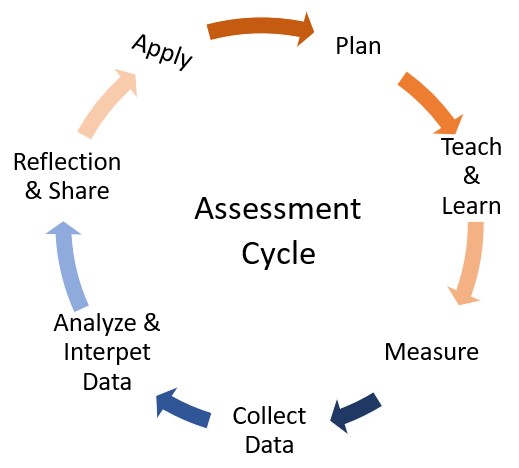Planning is an essential first step in the assessment cycle.
What learning outcomes do I intend to measure?
Faculty teaching General Education (Gen Ed) courses should reference the General Education curriculum map to identify the competency (critical thinking, written communication, quantitative reasoning, scientific literacy, civic engagement, or global cultural literacy) and its associated Student Learning Outcomes (SLOs) aligned to the course. The Gen Ed curriculum map will guide faculty in ensuring the correct competencies and SLO(s) are taught within their course(s).
General Education Course Map
Written Communication & Critical Thinking
Quantitative Reasoning & Scientific Literacy
Global Cultural Literacy & Civic Engagement
Alignment and integration of learning outcomes are the keys to successful assessment planning. Alignment is a process that ensures ILSLOs, CLSLOs, assessments, and course learning experiences are well connected. Adjustments to course learning outcomes, recalibration of assessment tools, or the inclusion of new learning experiences might be necessary to ensure proper alignment.
Planning then involves building your course(s) that provide students with opportunities to achieve these learning outcomes.
Plan Assessments:
The learning objectives will drive your choice of formative and summative assessment tools, determining which learning activities and instruction you plan for class time.
Formative assessments (Help Students to Improve)
These assessments are used to monitor student learning and provide feedback. They are often informal and less structured, including quizzes, outlines, drafts, games, projects, presentations, group activities, and more. Formative assessments are usually low stakes, meaning they have low or no point value and don't always need to be graded or marked. Formative assessments aim to improve student achievement of learning objectives and adjust teaching appropriately based on student needs.
Summative assessments (Students demonstrate what they learned)
These assessments are used to evaluate the sum total of skills or comprehension achieved at the end of the learning process (end-of-unit/module, chapter, or semester). They are often more formal and structured, including tests, final exams, reports, papers, and more. The goal of summative assessments is to evaluate student learning by comparing it against some standard or benchmark, and they are often high stakes, meaning they have a high point value.
Decide which course summative assignment will be used to measure and document how students accomplish the learning outcomes.
What is acceptable evidence of the student's understanding and proficiency?
Varying types: Quizzes and tests, case analyses, course projects, debates, essays, presentations, and more.
How do I know what assessment methods to use?
There are many tools and methods for assessing learning, but not all are appropriate for each of your learning objectives. The assessment tool you select should measure the learning outcome. Please reference Bloom’s Taxonomy domain (lower – higher order) and the verb used within the SLO to select the most appropriate assessment tool. Learn more about suggested assessment tools.
Plan Learning activities and instruction:
The last step in the planning phase is determining how and when students will be introduced to the SLO being assessed. What content must be taught (concepts, principles, facts) to students? In this step, faculty should identify materials and resources (examples, lectures, textbooks, articles, podcasts, videos, etc.) to present to students.
